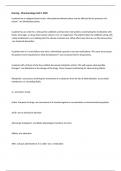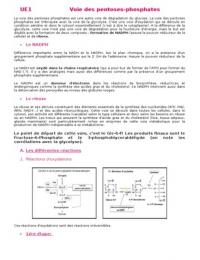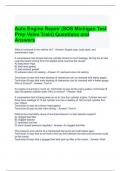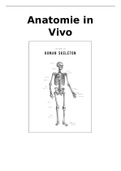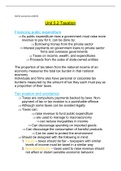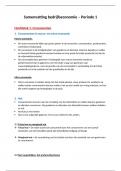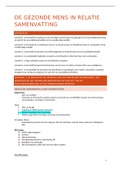Medische Microbiologie
Inhoud
Hoofdstuk 1: Microbiologie
1. Inleiding ............................................................................................................................. 9
2. Indeling Levende menselijke ziektekiemen ....................................................................... 9
2.1 Indeling onder 5 rijken ................................................................................................ 9
Prokaryoten ........................................................................................................................ 9
Protozoa: éencellige diertjes .............................................................................................. 9
Fungi: schimmels ............................................................................................................. 10
Wormen & geleedpotigen ................................................................................................ 10
Virussen ........................................................................................................................... 10
2.2 Indeling menselijke ziektekiemen volgens grootte ................................................... 11
2.3 Indeling menselijke ziektekiemen volgens habitat & ziekteverwekkend vermogen 11
1) Voorkomen in dode reservoirs .............................................................................. 11
2) Parasitair Bestaan .................................................................................................. 11
3. Naamgeving van een soort ............................................................................................... 11
4. Epidemiologie .................................................................................................................. 12
4.1 Overdracht van infecties............................................................................................ 12
4.1.1 Ingangspoorten ................................................................................................... 12
4.1.2 Besmettingsbronnen ........................................................................................... 12
4.1.3 Overdrachtswegen.............................................................................................. 13
4.2 Begrippen prevalentie en incidentie .......................................................................... 13
4.3 Verspreidingspatroon in de tijd ................................................................................. 13
4.4 Geografische verspreiding......................................................................................... 14
5. Beloopstadia van een infectieziekte ................................................................................. 14
5.1 Stadia van een acute infectie ..................................................................................... 14
Stadia van een acute infectie in relatie m bacteriële groeicurve ...................................... 14
Stadia van een acute infectie in relatie met afweermechanismen .................................... 15
Stadia recidief acute infectie in relatie met bacteriële groeicurve en secundaire
immuunrespons ................................................................................................................ 16
5.2 Stadia van een chronische infectie ............................................................................ 16
1
,Hoofdstuk 2: Bacteriologie
1. Structuur en organisatie van bacteriën ............................................................................. 17
1.1 Afmetingen ................................................................................................................ 17
1.2 Morfologie................................................................................................................. 17
1) Globale vorm ......................................................................................................... 17
2) Patroon van clustering ........................................................................................... 17
1.3 Opbouw van een bacterie of prokaryote cel .............................................................. 18
1.3.1 De celenvelop..................................................................................................... 18
1.3.2 Het cytoplasma................................................................................................... 19
1.3.3 Pili en flagellen .................................................................................................. 19
1.3.4 Nucleoïde kernequivalent .................................................................................. 19
1.3.5 Specifieke structuren (niet bij alle bacteria) ...................................................... 19
1.4 fysiologie van bacteriën ............................................................................................ 21
1.4.1 Voeding .............................................................................................................. 21
1.4.2 ATP-productie.................................................................................................... 21
1.4.3 T°-optimum ........................................................................................................ 21
1.4.4 pH-optimum ....................................................................................................... 21
1.4.5 Groei & vermenigvuldiging ............................................................................... 22
2. Bacteriële genetica ........................................................................................................... 22
2.1 Feno- & genotypische aanpassingen ......................................................................... 23
2.2 Wijzen van genotypische aanpassingen .................................................................... 23
2.2.1 Mutatie ............................................................................................................... 23
2.2.2 conjugatie ........................................................................................................... 23
2.2.3 Transformatie ..................................................................................................... 25
2.2.4 Transductie ......................................................................................................... 25
3. Ziekteverwekkend vermogen van bacteriën .................................................................... 27
3.1 Besmettelijkheid ........................................................................................................ 27
3.2 Pathogeen vermogen (virulentie) .............................................................................. 27
3.2.1 Lokale virulentie ................................................................................................ 28
3.2.2 SIRS → Sepsis → Septische shock ................................................................... 29
3.3 Pathogene vs. commensale stammen ........................................................................ 31
4. Verminderde weerstand ................................................................................................... 31
Hoofdstuk 3: Bacteriële toxi-infecties
1. Inleiding: Bacteriële toxi-infecties ................................................................................... 33
2. Gasgangreen (necrotiserende fasciitis-type II) ................................................................ 33
2
,3. Tetanus (klem) ................................................................................................................. 35
4. Botulisme ......................................................................................................................... 35
5. Voedselvergiftiging en gastro-enteritis ............................................................................ 36
5.1 Klassieke voedselvergiftiging ................................................................................... 36
5.2 Gastro-enteritis .......................................................................................................... 36
Hoofdstuk 4: Purulente bacteriële infecties
1. Inleiding: purulente bacteriële infecties ........................................................................... 39
1.1 Gelokaliseerde etterige infecties ............................................................................... 39
1.2 Lokalisatie spreidende etterige infecties ................................................................... 40
1.3 Metastatische (hematogene / secundaire) infectiehaarden ........................................ 40
1.3.1 Endocarditis ....................................................................................................... 40
1.3.2 Osteomyelitis ..................................................................................................... 41
1.3.3 Septische arthritis ............................................................................................... 41
1.4 Voornaamste pyogene bacteriën ............................................................................... 42
1.4.1 Staphylococcus aureus ....................................................................................... 42
1.4.2 Streptococcus pyegenes ..................................................................................... 44
1.4.3 Streptococcus Pneumoniae ................................................................................ 45
1.4.4 Haemophilus influenzae..................................................................................... 46
1.4.5 Neisseria meningitidis ........................................................................................ 46
1.4.6 Neisseria gonorrhea ........................................................................................... 47
1.4.7 Gramnegatieve darmbacteriën en anaëroben ..................................................... 47
1.4.8 Pseudomonas Aeruginosa (gr- bacil) ................................................................. 47
Hoofdstuk 5: Virologie
1. Bouw en morfologie ........................................................................................................ 49
2. Classificatie ...................................................................................................................... 50
3. Diagnostiek van een virusinfectie .................................................................................... 50
4. Virale replicatie ................................................................................................................ 52
4.1 Virale replicatie ......................................................................................................... 52
4.2 Reproductie RNA-virussen ....................................................................................... 53
4.3 Reproductie retro-virussen ........................................................................................ 54
4.4 Reproductie DNA-virussen ....................................................................................... 55
5. Verloop van een virale infectie ........................................................................................ 55
5.1 Lytische (snelle) virale infectie ................................................................................. 55
5.2 Chronisch persisterende/actieve infectie ................................................................... 55
5.3 Latente infectie .......................................................................................................... 56
3
, 5.4 Oncogene virussen .................................................................................................... 56
Hoofdstuk 6: Virale infecties
1. Influenzavirus .................................................................................................................. 57
1.1 Mutaties ..................................................................................................................... 57
1.1.1 Genetic Drift ...................................................................................................... 57
1.1.2 Genetic Shift ...................................................................................................... 57
1.1.3 Anti-genetic drift & shift ................................................................................... 58
1.2 Griep (ziekte verloop) ............................................................................................... 58
1.3 Seizoensgriep; een dodelijke infectie? ...................................................................... 58
2. Poliovirus → Poliomyelitis .............................................................................................. 59
3. Papillomavirussen ............................................................................................................ 59
3.1 Huidwratten ............................................................................................................... 59
3.2 Slijmvlieswratten ....................................................................................................... 59
4. Humane herpesvirussen ................................................................................................... 61
4.1 Herpes Simplex Virus I ............................................................................................. 61
4.1.1 Voorbeelden ....................................................................................................... 61
4.2 Herpes simplex II ...................................................................................................... 62
4.3 Varicella zoster virus (VZV) ..................................................................................... 63
4.3.1 Verloop primo-infectie....................................................................................... 63
4.3.2 Reactivatie = zona (gordelroos) ......................................................................... 64
4.4 Epstein-Barr virus (EBV) .......................................................................................... 65
4.4.1 EBV beloop ........................................................................................................ 65
4.4.2 EBV –> Klierkoorts ........................................................................................... 65
4.5 Cytomegalovirus (CMV)........................................................................................... 65
5. Hepatotrope virussen ....................................................................................................... 66
5.1 Hepatitis A virus → Soldatengeelzucht .................................................................... 66
5.2 Hepatitis B virus ........................................................................................................ 66
5.3 Hepatitis C virus ........................................................................................................ 66
5.3.1 Levercirrose ....................................................................................................... 67
Hoofdstuk 7: Mycologie
1. Bouw en eigenschappen van fungi .................................................................................. 69
2. Indeling van fungi ............................................................................................................ 71
2.1 Volgens verschijningsvorm ....................................................................................... 71
2.2 Volgens aspect seksuele voortplantingsorganen ....................................................... 71
3. Soorten mycosen .............................................................................................................. 72
4
,4. Diagnosestelling ............................................................................................................... 72
Hoofdstuk 8: Schimmelinfecties
1. Candida Albicans (Monilia) ............................................................................................. 73
2. Pityrosporum Ovale → Seborroïsch eczeem ................................................................... 74
3. Dermatofyten ................................................................................................................... 75
Hoofdstuk 9: Parasitologie
1. Definitie parasiet en soorten parasitisme ......................................................................... 77
2. Indeling parasieten ........................................................................................................... 77
2.1 Eencellige parasieten (protozoa) ............................................................................... 77
2.2 Meercellige parasieten (metazoa).............................................................................. 78
3. Parasitaire ontwikkelingscyclus ....................................................................................... 78
Hoofdstuk 10: Parasitaire infecties
1. Entamoebe histolytica ...................................................................................................... 79
2. Naeglaeria fowleri ............................................................................................................ 79
3. Balantidium Coli .............................................................................................................. 80
4. Giardia Lamblia ............................................................................................................... 80
5. Trichomonas Vaginalis .................................................................................................... 81
6. Trypanosoma Gambiense (slaapziekte) ........................................................................... 81
7. Plasmodium...................................................................................................................... 82
8. Toxoplasma gondii........................................................................................................... 82
9. Taenia saginata / solium (runder- & varkenslintworm) ................................................... 83
10. Fasciola hepatica (leverbot) .......................................................................................... 83
11. Schistosoma .................................................................................................................. 84
12. Oxyurus / enterobius Vermicularis (aarsmade) ............................................................ 84
13. Ascaris Lumbricoides (spoelworm) .............................................................................. 84
14. Pediculus humanis (hoofdluis) ...................................................................................... 85
15. Pulex irritans (vlo) ........................................................................................................ 85
16. Ixodes daminii (teek) .................................................................................................... 85
17. Scabies: schurft ............................................................................................................. 85
Hoofdstuk 11: Diagnostische onderzoeken
1. Microbiologische staalafname ......................................................................................... 87
1.1 Mogelijke afnames .................................................................................................... 87
1.1.1 keelsecreet .......................................................................................................... 87
1.1.2 Oorsecreet .......................................................................................................... 88
5
, 1.1.3 Sputum ............................................................................................................... 88
1.1.4 Faeces ................................................................................................................. 88
1.1.5 Urine .................................................................................................................. 88
1.1.6 Urethaal / cervixsecreet...................................................................................... 89
1.1.7 Genitaalsecreet ................................................................................................... 89
1.1.8 Huid- en wondinfecties, huidabcessen ............................................................... 89
1.1.9 Cerebrospinaal vocht ......................................................................................... 89
1.1.10 Bloed .................................................................................................................. 89
2. Labo-onderzoeken............................................................................................................ 90
2.1 RMO (rechtstreeks microscopisch onderzoek) ......................................................... 90
2.1.1 Lichtmicroscoop ................................................................................................ 90
2.1.2 fluorescentiemicroscopie ................................................................................... 90
2.1.3 Fasecontrast microscoop .................................................................................... 90
2.1.4 Donkerverldmicroscoop ..................................................................................... 91
2.1.5 Elektronenmicroscoop ....................................................................................... 91
2.1.6 RMO van sputum ............................................................................................... 91
2.1.7 RMO van etter.................................................................................................... 91
2.1.8 RMO van bloeduitstrijkje .................................................................................. 92
2.1.9 RMO met telkamer ............................................................................................ 92
2.2 Kweek (van bacteriën en schimmels)........................................................................ 92
2.2.1 Met oog op identificatie en typering van een kiem............................................ 92
2.2.2 Meng- & reincultuur .......................................................................................... 92
2.2.3 Antibiogram m snelle schijfjesmethoden........................................................... 93
2.2.4 Bepaling van antibioticum gevoeligheid (MIC) ahv dilutie-methode ............... 93
2.2.5 Kwantitatieve kweek v urine, tellen van het aantal CFU’s ................................ 94
2.2.6 Semi-kwantitatieve kweek v urine op “dipslide”............................................... 94
2.3 Urinestrips ................................................................................................................. 95
2.4 Serologisch onderzoek .............................................................................................. 95
2.5 Antigendetectie.......................................................................................................... 95
2.5.1 Sandwich ELISA-methode ................................................................................ 95
2.6 RNA/DNA-detectie ................................................................................................... 96
Hoofdstuk 12: Antimicrobiële middelen
1. Inleiding ........................................................................................................................... 97
2. Begrippen en definities .................................................................................................... 97
3. Werkingsmechanismen .................................................................................................... 99
6
, 3.1 Antimetabolieten ....................................................................................................... 99
3.2 Interferentie met de celwandsynthese ....................................................................... 99
3.3 Verhogen permeabiliteit celmembraan ................................................................... 100
3.4 Remming v bacteriële eiwitsynthese ....................................................................... 100
3.5 Interferentie met DNA-synthese ............................................................................. 100
3.6 Combinaties van antibiotica (AB) ........................................................................... 100
4. Resistentie v bacteriën aan antibiotica ........................................................................... 101
4.1 Uitbreiding verworven resistentie in een populatie................................................. 101
4.2 Mechanismen aan basis v AB resistentie ................................................................ 101
4.3 Preventie van resistentie .......................................................................................... 102
4.4 Meest bekende (multi-) resistente (ZH) kiemen ..................................................... 102
5. MRSA problematiek ...................................................................................................... 102
5.1 Inleiding .................................................................................................................. 102
5.2 Epidemiologie ......................................................................................................... 102
5.3 Preventie en controlemaatregelen ........................................................................... 103
Hoofdstuk 13: Commensale flora
1. Verwerven van de normale flora.................................................................................... 105
2. Aard vd micro-organismen ............................................................................................ 105
3. Plaats van voorkomen .................................................................................................... 105
4. Voor- en nadelen ............................................................................................................ 106
5. Residentiële flora van verschillende organen ................................................................ 107
5.1 De huid .................................................................................................................... 107
5.2 Luchtwegen ............................................................................................................. 107
5.2.1 Mond, neus en keel (>109).............................................................................. 107
5.2.2 Rest vh ademhalingsstelsel is steriel ................................................................ 108
5.3 Darmkanaal ............................................................................................................. 108
5.4 Urine- & geslachtswegen ........................................................................................ 108
7
,8
,Hoofdstuk 1: Microbiologie
1. Inleiding
Medische microbiologie: Bestudeert verwekkers van infectueuze ziekten, nl. menselijke
ziektekiemen / pathogenen
• Bacteriën
• Schimmels
• Parasieten:
o Protozoa (1-cellig)
o Wormen , geleedpotigen
2. Indeling Levende menselijke ziektekiemen
2.1 Indeling onder 5 rijken
5 rijken:
- Prokaryoten
- Planten
- Fungi: Gisten en zwammen Eukaryoten
- Eencellige dieren: Protozoa
- Meercellige dieren
!! Virussen: geen levende organismen !!
• Geen eigen voortplanting
• Hebben anderen nodig voor leven
Prokaryoten
• Oudste levensvorm
• Geen kern, maar kernequivalent: Nucleoïd
• Genofoor: 1 enkel circulair DNA
• Stijve celwand
• Geen organellen, enkel ribosomen
• Binaire splijting
• Soms vorming v endosporen, onder ongunstige
omstandigheden
Protozoa: éencellige diertjes
• 1 of meer kernen (haploïd / diploïd)
• Voortbeweging adhv
o Pseudopoden
o Flagella
o Sommigen onbeweeglijk
• Voortplanting:
o Ongeslachtelijk: mitose / Knopvorming
o Geslachtelijk: meiose met vorming v gameten
9
, • Ongunstige omstandigheden → Resistente cysten
Fungi: schimmels
• kernen
• Organellen
• Celwand
• Onbeweeglijk
• 1-cellig / Meercellig
• Voortplanting
o Ongeslachtelijk, mitosporen, knopvorming
o Geslachtelijk do meiose m vorming v meiosporen
Wormen & geleedpotigen
• Meercellig → Celdifferentiatie
• Hebben GI-buis & monddelen
• 1 diploïde kern + organellen
• Geen celwand
• Geslachtelijke voortplanting
Virussen
• Niet-levende, besmettelijke partikels
• Eiwitmantel rond DNA / RNA
• Intracellulaire ziektekiemen
• Na opname id cel → Replicatie do cellulaire enzymen
vo transcriptie & translatie → °miljoenen nieuwe virions
→ Cel spat open
SAMENVATTING
10
Inhoud
Hoofdstuk 1: Microbiologie
1. Inleiding ............................................................................................................................. 9
2. Indeling Levende menselijke ziektekiemen ....................................................................... 9
2.1 Indeling onder 5 rijken ................................................................................................ 9
Prokaryoten ........................................................................................................................ 9
Protozoa: éencellige diertjes .............................................................................................. 9
Fungi: schimmels ............................................................................................................. 10
Wormen & geleedpotigen ................................................................................................ 10
Virussen ........................................................................................................................... 10
2.2 Indeling menselijke ziektekiemen volgens grootte ................................................... 11
2.3 Indeling menselijke ziektekiemen volgens habitat & ziekteverwekkend vermogen 11
1) Voorkomen in dode reservoirs .............................................................................. 11
2) Parasitair Bestaan .................................................................................................. 11
3. Naamgeving van een soort ............................................................................................... 11
4. Epidemiologie .................................................................................................................. 12
4.1 Overdracht van infecties............................................................................................ 12
4.1.1 Ingangspoorten ................................................................................................... 12
4.1.2 Besmettingsbronnen ........................................................................................... 12
4.1.3 Overdrachtswegen.............................................................................................. 13
4.2 Begrippen prevalentie en incidentie .......................................................................... 13
4.3 Verspreidingspatroon in de tijd ................................................................................. 13
4.4 Geografische verspreiding......................................................................................... 14
5. Beloopstadia van een infectieziekte ................................................................................. 14
5.1 Stadia van een acute infectie ..................................................................................... 14
Stadia van een acute infectie in relatie m bacteriële groeicurve ...................................... 14
Stadia van een acute infectie in relatie met afweermechanismen .................................... 15
Stadia recidief acute infectie in relatie met bacteriële groeicurve en secundaire
immuunrespons ................................................................................................................ 16
5.2 Stadia van een chronische infectie ............................................................................ 16
1
,Hoofdstuk 2: Bacteriologie
1. Structuur en organisatie van bacteriën ............................................................................. 17
1.1 Afmetingen ................................................................................................................ 17
1.2 Morfologie................................................................................................................. 17
1) Globale vorm ......................................................................................................... 17
2) Patroon van clustering ........................................................................................... 17
1.3 Opbouw van een bacterie of prokaryote cel .............................................................. 18
1.3.1 De celenvelop..................................................................................................... 18
1.3.2 Het cytoplasma................................................................................................... 19
1.3.3 Pili en flagellen .................................................................................................. 19
1.3.4 Nucleoïde kernequivalent .................................................................................. 19
1.3.5 Specifieke structuren (niet bij alle bacteria) ...................................................... 19
1.4 fysiologie van bacteriën ............................................................................................ 21
1.4.1 Voeding .............................................................................................................. 21
1.4.2 ATP-productie.................................................................................................... 21
1.4.3 T°-optimum ........................................................................................................ 21
1.4.4 pH-optimum ....................................................................................................... 21
1.4.5 Groei & vermenigvuldiging ............................................................................... 22
2. Bacteriële genetica ........................................................................................................... 22
2.1 Feno- & genotypische aanpassingen ......................................................................... 23
2.2 Wijzen van genotypische aanpassingen .................................................................... 23
2.2.1 Mutatie ............................................................................................................... 23
2.2.2 conjugatie ........................................................................................................... 23
2.2.3 Transformatie ..................................................................................................... 25
2.2.4 Transductie ......................................................................................................... 25
3. Ziekteverwekkend vermogen van bacteriën .................................................................... 27
3.1 Besmettelijkheid ........................................................................................................ 27
3.2 Pathogeen vermogen (virulentie) .............................................................................. 27
3.2.1 Lokale virulentie ................................................................................................ 28
3.2.2 SIRS → Sepsis → Septische shock ................................................................... 29
3.3 Pathogene vs. commensale stammen ........................................................................ 31
4. Verminderde weerstand ................................................................................................... 31
Hoofdstuk 3: Bacteriële toxi-infecties
1. Inleiding: Bacteriële toxi-infecties ................................................................................... 33
2. Gasgangreen (necrotiserende fasciitis-type II) ................................................................ 33
2
,3. Tetanus (klem) ................................................................................................................. 35
4. Botulisme ......................................................................................................................... 35
5. Voedselvergiftiging en gastro-enteritis ............................................................................ 36
5.1 Klassieke voedselvergiftiging ................................................................................... 36
5.2 Gastro-enteritis .......................................................................................................... 36
Hoofdstuk 4: Purulente bacteriële infecties
1. Inleiding: purulente bacteriële infecties ........................................................................... 39
1.1 Gelokaliseerde etterige infecties ............................................................................... 39
1.2 Lokalisatie spreidende etterige infecties ................................................................... 40
1.3 Metastatische (hematogene / secundaire) infectiehaarden ........................................ 40
1.3.1 Endocarditis ....................................................................................................... 40
1.3.2 Osteomyelitis ..................................................................................................... 41
1.3.3 Septische arthritis ............................................................................................... 41
1.4 Voornaamste pyogene bacteriën ............................................................................... 42
1.4.1 Staphylococcus aureus ....................................................................................... 42
1.4.2 Streptococcus pyegenes ..................................................................................... 44
1.4.3 Streptococcus Pneumoniae ................................................................................ 45
1.4.4 Haemophilus influenzae..................................................................................... 46
1.4.5 Neisseria meningitidis ........................................................................................ 46
1.4.6 Neisseria gonorrhea ........................................................................................... 47
1.4.7 Gramnegatieve darmbacteriën en anaëroben ..................................................... 47
1.4.8 Pseudomonas Aeruginosa (gr- bacil) ................................................................. 47
Hoofdstuk 5: Virologie
1. Bouw en morfologie ........................................................................................................ 49
2. Classificatie ...................................................................................................................... 50
3. Diagnostiek van een virusinfectie .................................................................................... 50
4. Virale replicatie ................................................................................................................ 52
4.1 Virale replicatie ......................................................................................................... 52
4.2 Reproductie RNA-virussen ....................................................................................... 53
4.3 Reproductie retro-virussen ........................................................................................ 54
4.4 Reproductie DNA-virussen ....................................................................................... 55
5. Verloop van een virale infectie ........................................................................................ 55
5.1 Lytische (snelle) virale infectie ................................................................................. 55
5.2 Chronisch persisterende/actieve infectie ................................................................... 55
5.3 Latente infectie .......................................................................................................... 56
3
, 5.4 Oncogene virussen .................................................................................................... 56
Hoofdstuk 6: Virale infecties
1. Influenzavirus .................................................................................................................. 57
1.1 Mutaties ..................................................................................................................... 57
1.1.1 Genetic Drift ...................................................................................................... 57
1.1.2 Genetic Shift ...................................................................................................... 57
1.1.3 Anti-genetic drift & shift ................................................................................... 58
1.2 Griep (ziekte verloop) ............................................................................................... 58
1.3 Seizoensgriep; een dodelijke infectie? ...................................................................... 58
2. Poliovirus → Poliomyelitis .............................................................................................. 59
3. Papillomavirussen ............................................................................................................ 59
3.1 Huidwratten ............................................................................................................... 59
3.2 Slijmvlieswratten ....................................................................................................... 59
4. Humane herpesvirussen ................................................................................................... 61
4.1 Herpes Simplex Virus I ............................................................................................. 61
4.1.1 Voorbeelden ....................................................................................................... 61
4.2 Herpes simplex II ...................................................................................................... 62
4.3 Varicella zoster virus (VZV) ..................................................................................... 63
4.3.1 Verloop primo-infectie....................................................................................... 63
4.3.2 Reactivatie = zona (gordelroos) ......................................................................... 64
4.4 Epstein-Barr virus (EBV) .......................................................................................... 65
4.4.1 EBV beloop ........................................................................................................ 65
4.4.2 EBV –> Klierkoorts ........................................................................................... 65
4.5 Cytomegalovirus (CMV)........................................................................................... 65
5. Hepatotrope virussen ....................................................................................................... 66
5.1 Hepatitis A virus → Soldatengeelzucht .................................................................... 66
5.2 Hepatitis B virus ........................................................................................................ 66
5.3 Hepatitis C virus ........................................................................................................ 66
5.3.1 Levercirrose ....................................................................................................... 67
Hoofdstuk 7: Mycologie
1. Bouw en eigenschappen van fungi .................................................................................. 69
2. Indeling van fungi ............................................................................................................ 71
2.1 Volgens verschijningsvorm ....................................................................................... 71
2.2 Volgens aspect seksuele voortplantingsorganen ....................................................... 71
3. Soorten mycosen .............................................................................................................. 72
4
,4. Diagnosestelling ............................................................................................................... 72
Hoofdstuk 8: Schimmelinfecties
1. Candida Albicans (Monilia) ............................................................................................. 73
2. Pityrosporum Ovale → Seborroïsch eczeem ................................................................... 74
3. Dermatofyten ................................................................................................................... 75
Hoofdstuk 9: Parasitologie
1. Definitie parasiet en soorten parasitisme ......................................................................... 77
2. Indeling parasieten ........................................................................................................... 77
2.1 Eencellige parasieten (protozoa) ............................................................................... 77
2.2 Meercellige parasieten (metazoa).............................................................................. 78
3. Parasitaire ontwikkelingscyclus ....................................................................................... 78
Hoofdstuk 10: Parasitaire infecties
1. Entamoebe histolytica ...................................................................................................... 79
2. Naeglaeria fowleri ............................................................................................................ 79
3. Balantidium Coli .............................................................................................................. 80
4. Giardia Lamblia ............................................................................................................... 80
5. Trichomonas Vaginalis .................................................................................................... 81
6. Trypanosoma Gambiense (slaapziekte) ........................................................................... 81
7. Plasmodium...................................................................................................................... 82
8. Toxoplasma gondii........................................................................................................... 82
9. Taenia saginata / solium (runder- & varkenslintworm) ................................................... 83
10. Fasciola hepatica (leverbot) .......................................................................................... 83
11. Schistosoma .................................................................................................................. 84
12. Oxyurus / enterobius Vermicularis (aarsmade) ............................................................ 84
13. Ascaris Lumbricoides (spoelworm) .............................................................................. 84
14. Pediculus humanis (hoofdluis) ...................................................................................... 85
15. Pulex irritans (vlo) ........................................................................................................ 85
16. Ixodes daminii (teek) .................................................................................................... 85
17. Scabies: schurft ............................................................................................................. 85
Hoofdstuk 11: Diagnostische onderzoeken
1. Microbiologische staalafname ......................................................................................... 87
1.1 Mogelijke afnames .................................................................................................... 87
1.1.1 keelsecreet .......................................................................................................... 87
1.1.2 Oorsecreet .......................................................................................................... 88
5
, 1.1.3 Sputum ............................................................................................................... 88
1.1.4 Faeces ................................................................................................................. 88
1.1.5 Urine .................................................................................................................. 88
1.1.6 Urethaal / cervixsecreet...................................................................................... 89
1.1.7 Genitaalsecreet ................................................................................................... 89
1.1.8 Huid- en wondinfecties, huidabcessen ............................................................... 89
1.1.9 Cerebrospinaal vocht ......................................................................................... 89
1.1.10 Bloed .................................................................................................................. 89
2. Labo-onderzoeken............................................................................................................ 90
2.1 RMO (rechtstreeks microscopisch onderzoek) ......................................................... 90
2.1.1 Lichtmicroscoop ................................................................................................ 90
2.1.2 fluorescentiemicroscopie ................................................................................... 90
2.1.3 Fasecontrast microscoop .................................................................................... 90
2.1.4 Donkerverldmicroscoop ..................................................................................... 91
2.1.5 Elektronenmicroscoop ....................................................................................... 91
2.1.6 RMO van sputum ............................................................................................... 91
2.1.7 RMO van etter.................................................................................................... 91
2.1.8 RMO van bloeduitstrijkje .................................................................................. 92
2.1.9 RMO met telkamer ............................................................................................ 92
2.2 Kweek (van bacteriën en schimmels)........................................................................ 92
2.2.1 Met oog op identificatie en typering van een kiem............................................ 92
2.2.2 Meng- & reincultuur .......................................................................................... 92
2.2.3 Antibiogram m snelle schijfjesmethoden........................................................... 93
2.2.4 Bepaling van antibioticum gevoeligheid (MIC) ahv dilutie-methode ............... 93
2.2.5 Kwantitatieve kweek v urine, tellen van het aantal CFU’s ................................ 94
2.2.6 Semi-kwantitatieve kweek v urine op “dipslide”............................................... 94
2.3 Urinestrips ................................................................................................................. 95
2.4 Serologisch onderzoek .............................................................................................. 95
2.5 Antigendetectie.......................................................................................................... 95
2.5.1 Sandwich ELISA-methode ................................................................................ 95
2.6 RNA/DNA-detectie ................................................................................................... 96
Hoofdstuk 12: Antimicrobiële middelen
1. Inleiding ........................................................................................................................... 97
2. Begrippen en definities .................................................................................................... 97
3. Werkingsmechanismen .................................................................................................... 99
6
, 3.1 Antimetabolieten ....................................................................................................... 99
3.2 Interferentie met de celwandsynthese ....................................................................... 99
3.3 Verhogen permeabiliteit celmembraan ................................................................... 100
3.4 Remming v bacteriële eiwitsynthese ....................................................................... 100
3.5 Interferentie met DNA-synthese ............................................................................. 100
3.6 Combinaties van antibiotica (AB) ........................................................................... 100
4. Resistentie v bacteriën aan antibiotica ........................................................................... 101
4.1 Uitbreiding verworven resistentie in een populatie................................................. 101
4.2 Mechanismen aan basis v AB resistentie ................................................................ 101
4.3 Preventie van resistentie .......................................................................................... 102
4.4 Meest bekende (multi-) resistente (ZH) kiemen ..................................................... 102
5. MRSA problematiek ...................................................................................................... 102
5.1 Inleiding .................................................................................................................. 102
5.2 Epidemiologie ......................................................................................................... 102
5.3 Preventie en controlemaatregelen ........................................................................... 103
Hoofdstuk 13: Commensale flora
1. Verwerven van de normale flora.................................................................................... 105
2. Aard vd micro-organismen ............................................................................................ 105
3. Plaats van voorkomen .................................................................................................... 105
4. Voor- en nadelen ............................................................................................................ 106
5. Residentiële flora van verschillende organen ................................................................ 107
5.1 De huid .................................................................................................................... 107
5.2 Luchtwegen ............................................................................................................. 107
5.2.1 Mond, neus en keel (>109).............................................................................. 107
5.2.2 Rest vh ademhalingsstelsel is steriel ................................................................ 108
5.3 Darmkanaal ............................................................................................................. 108
5.4 Urine- & geslachtswegen ........................................................................................ 108
7
,8
,Hoofdstuk 1: Microbiologie
1. Inleiding
Medische microbiologie: Bestudeert verwekkers van infectueuze ziekten, nl. menselijke
ziektekiemen / pathogenen
• Bacteriën
• Schimmels
• Parasieten:
o Protozoa (1-cellig)
o Wormen , geleedpotigen
2. Indeling Levende menselijke ziektekiemen
2.1 Indeling onder 5 rijken
5 rijken:
- Prokaryoten
- Planten
- Fungi: Gisten en zwammen Eukaryoten
- Eencellige dieren: Protozoa
- Meercellige dieren
!! Virussen: geen levende organismen !!
• Geen eigen voortplanting
• Hebben anderen nodig voor leven
Prokaryoten
• Oudste levensvorm
• Geen kern, maar kernequivalent: Nucleoïd
• Genofoor: 1 enkel circulair DNA
• Stijve celwand
• Geen organellen, enkel ribosomen
• Binaire splijting
• Soms vorming v endosporen, onder ongunstige
omstandigheden
Protozoa: éencellige diertjes
• 1 of meer kernen (haploïd / diploïd)
• Voortbeweging adhv
o Pseudopoden
o Flagella
o Sommigen onbeweeglijk
• Voortplanting:
o Ongeslachtelijk: mitose / Knopvorming
o Geslachtelijk: meiose met vorming v gameten
9
, • Ongunstige omstandigheden → Resistente cysten
Fungi: schimmels
• kernen
• Organellen
• Celwand
• Onbeweeglijk
• 1-cellig / Meercellig
• Voortplanting
o Ongeslachtelijk, mitosporen, knopvorming
o Geslachtelijk do meiose m vorming v meiosporen
Wormen & geleedpotigen
• Meercellig → Celdifferentiatie
• Hebben GI-buis & monddelen
• 1 diploïde kern + organellen
• Geen celwand
• Geslachtelijke voortplanting
Virussen
• Niet-levende, besmettelijke partikels
• Eiwitmantel rond DNA / RNA
• Intracellulaire ziektekiemen
• Na opname id cel → Replicatie do cellulaire enzymen
vo transcriptie & translatie → °miljoenen nieuwe virions
→ Cel spat open
SAMENVATTING
10

